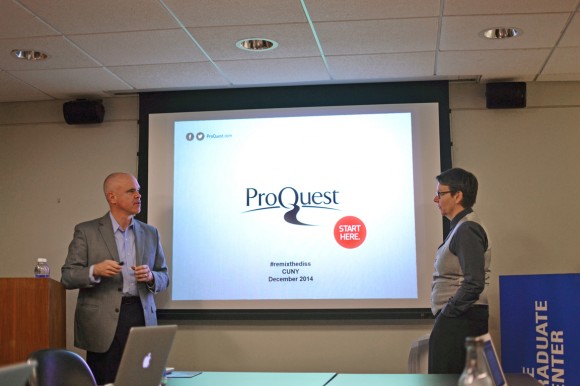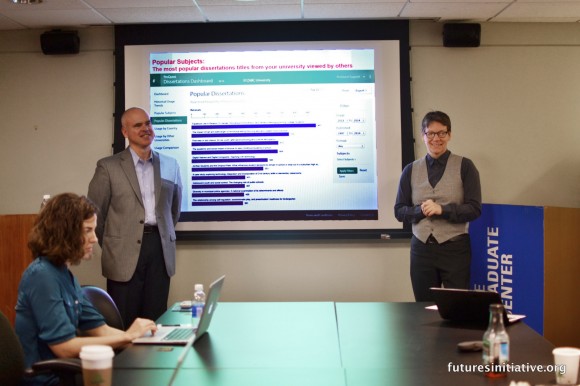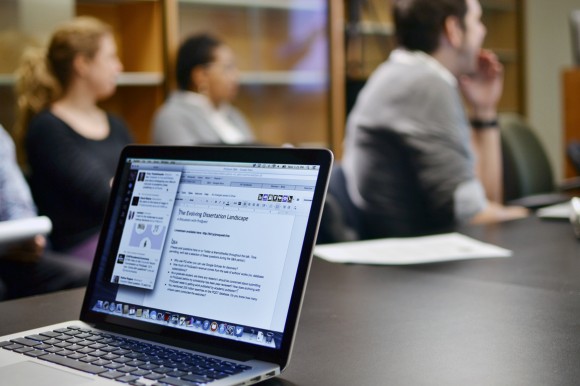On December 1, 2014 the Futures Initiative along with JustPublics@365 and the Mina Rees Library at The Graduate Center, CUNY, hosted a discussion with Austin McLean, Director of Scholarly Communication and Dissertations Publishing at ProQuest®.
Polly Thistlethwaite, Chief Librarian at the Mina Rees Library, opened the discussion with a look back at how the Graduate Center has historically dealt with the publication and archiving of dissertations.
A Short Timeline of Dissertation Publishing at the Graduate Center
1962 – The Bulletin of the Graduate Center included a requirement that dissertations would be defended at a final oral examination and then must be either published or microfilmed before the doctorate degree could be granted. The Graduate Center like many other universities, used UMI microfilm to publish and archive graduate work.
1965 – CUNY published its first dissertation with UMI. At the time, the library had two paper archival copies and the department kept one paper copy. UMI was also sent a paper copy and then sent back a microfilm to the library as an additional archival copy. The UMI dissertations abstracts could be accessed in almost every academic/public library. UMI was situated to produce this publication given its microfilming role across universities. No single university was able to compile all of this information.
1996 – UMI began digitizing new dissertations submitted in paper. The Graduate Center library still received microfilm for archival purposes. In addition, many paper copies were still kept for archival purposes. Authors were always given the option to embargo the work and did not have to allow sales in microfilm or any other format.
2005 – The Graduate Center library began sending dissertations digitally to UMI and ProQuest as PDFs rather than as paper copies. Paper copies are still kept for archival purposes by the Graduate Center library.
2007 – The Graduate Center library began subscribing to the UMI ProQuest full-text dissertation database online. CUNY library users can now have access to dissertations from all over the world.
2014 – The Graduate Center added Academic Works institutional repository. Now authors submit digital copies of works through the UMI ProQuest database and the full text of the submission and the metadata generated from the company can be archived into our institutional repository. Authors still have the option of making their work open access or embargoing for as long a period as they choose.
ProQuest’s Dissertation and Thesis Distribution Program and Database
Austin began by explaining how ProQuest is moving away from using the word “publishing” because it has been confusing in the past for authors of graduate work. He explained that ProQuest sees its role not akin to a monograph publisher but rather as a disseminator of research to the global academic community via ProQuest’s network of 1,700 graduate schools and universities the world over.
In 2014, ProQuest surpassed the 100,000 mark with 110,000 dissertations and theses published, archived, and disseminated annually. The ProQuest archive stretches back to 1763 and includes 3.8 million graduate works. More than 3,000 libraries around the world have access to the dissertations and masters theses. It is also made available through the Dissertation Collection of the Library of Congress. Citations from the archive are also made available to major field and subject specific indexes (e.g. ChemAbstracts, PsycINFO, ERIC, MathSciNet, ABI/INFORM, Philosopher’s Index, etc.)
Austin noted that many undergraduate students use the dissertation and thesis database in their determination process for deciding where to pursue graduate studies, what professors and researchers to work with, and what types of dissertations and masters theses are being worked on in particular places and with particular professors. In addition, counselors and advisors may use the database as a resource to help guide students through the research and career planning process. Some nontraditional uses of the database include recruitment and hiring for companies, organizations, and agencies.
Austin said that many authors feel like they are contributing to the history of their discipline by including their work in the research distribution program. He also clarified that authors remain the copyright holders of their work and that a 10% royalty is paid to authors on any sales made of their dissertation or thesis. As the royalty is accumulated over time, it is paid out to authors when the balance rises above $25. Royalties are generated every time an institution like CUNY subscribes to the full text or when individual researchers or users pay to download the full text PDF. The agreement between authors and ProQuest further fleshes out this information.
Dissertation Dashboard – Coming soon to a University near You
ProQuest has already released the program Dissertations Dashboard, developed by ProQuest Labs, to several universities in a Beta release designed to gain feedback. In 2015, it will be available to even more.
The dashboard enables universities to see trends over time and metrics on what work is being done across an institution. The dashboard allows tracking for total distribution of graduate work as well as university usage. The system will be able to explore usage patterns down to the individual dissertation/thesis level and also allows for data tracking by geography and subject area. The program is currently given to universities at no fee.
Interested in having access to this data for your own graduate work? ProQuest is also currently thinking about doing a similar dashboard system for authors and are seeking comments and feedback.
Audience members at the event noted that the dashboard is important at the individual level as well because many universities are already developing the ability to do this type of data tracking and analysis for how their work is being used.
Archiving Multimedia Work
Another question from the audience asked whether ProQuest had the capacity to include different formats and media for dissertations and theses and how those non-traditional files and supplements are archived.
Austin explained that the decision to include and archive multimedia work usually comes down to university policy. Some universities do not allow any kinds of supplements. However, if university policy does allow supplements and nontraditional formats then ProQuest also allows it and makes those available. He said that for about 95% of dissertations, the default format is a PDF and then any additional files or media submitted as supplements.
Like the print materials, ProQuest editors go through the nontraditional content and denote keywords, index and subject headings, and other metadata that help make the supplemental content discoverable in the database.
Digitally Archiving Old Dissertations and Theses
For a variety of reasons, many university libraries are moving to digitally archive their print and microfilm copies of dissertations and theses. For some universities, preservation is the key driver. Other universities want to make academic commons with digital files available to the community at large. Still others want to create more space in the library. Whatever the reason, ProQuest often works with universities to go back and retrospectively digitize older dissertations and theses. A digital copy is then kept in the ProQuest database as well as in the institutional repository (if rights allow).
CUNY libraries wanted to digitize to make graduate work available to as broad an audience as possible. The Alumni Association supported the decision. CUNY libraries contracted with ProQuest to convert the microfilm and a few paper copies into digital formats. Now all the CUNY dissertations are digitized and available in full text. Instead of microfilm which had to be accessed at the library, the digital format makes the work more accessible to more readers. One of the reasons CUNY libraries went with ProQuest was because of the higher labor costs involved with having the work done in-house.
Embargoing Your Work
It may make sense for some researchers to decide to embargo their work from appearing through the ProQuest distribution system. With ProQuest, authors have the ability to change their decision about embargoing or not embargoing their work. If the author decides, for example, that they want their work embargoed after previously having it available, they can contact ProQuest and the work will be made unavailable within 24 hours. The same is true if you decide you want to un-embargo your work.
If students decide to change their mind about embargoing, they must also let their institutional repository/library know. The capacity to embargo for different periods of time usually depends on what the university policy is. The default embargo is between six months and one year. At CUNY libraries, students are allowed to embargo for periods of six months, one year, or two years and that information is sent to ProQuest. If a student wants to embargo for a longer period of time or even a lifetime, they are directed to ProQuest for that request.
Some institutions and universities do not work with ProQuest due to mandates about public accessibility. Other universities have elected not to work with ProQuest to avoid commercial interaction. For individual authors that want to get around the commercial factor of ProQuest, copies can be submitted to both the institutional repository and ProQuest. The author can than embargo with ProQuest but not embargo with the institutional repository that the academic work was conducted at so that it will only be available freely via that institution and will not be available via ProQuest.
ProQuest Revenue
A question posed from the audience asked how ProQuest generates its revenue streams and cited debate over ProQuest allowing the sale of authors’ work on Amazon and other venues.
Austin explained that ProQuest generates much of its revenue from the sale of subscriptions to libraries, mostly academic libraries but also some corporate customers and government libraries. The second revenue stream is from the sale of individual copies of dissertations and theses made to individual researchers or others who pay to download a PDF copy or request a paper or microfilm copy.
Regarding third-party distribution, Austin said that ProQuest has halted distribution through Amazon and other outlets. He said that initially the research community was interested in that program, but there was a lot of confusion and problems resulting from that process for institutions, authors, and ProQuest. Some of the confusion related to the agreements between authors and ProQuest regarding sale via third-party channels, but no agreements of those kind exist anymore.
Published Years Ago and Wondering if You Have Royalties?
Anyone who has published years ago and has not received royalties or communication from ProQuest should e-mail [email protected] for inquiries.
ProQuest needs to have current address information on authors in order to be able to pay out the royalty checks generated from the sale and subscription of individual dissertations and theses. Make sure to contact ProQuest and update your information whenever you move.
This discussion built on questions raised during a prior event, “What Is a Dissertation?”, organized by the Futures Initiative at the Graduate Center, City University of New York, and jointly sponsored by HASTAC, Duke University, the CUNY Digital Humanities Initiative, the Graduate Center Library, and twenty virtual partners in North America and abroad.




